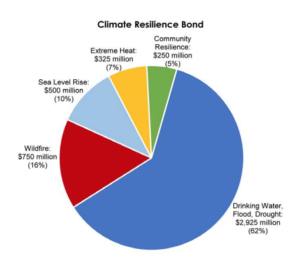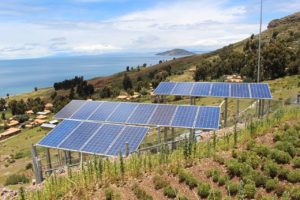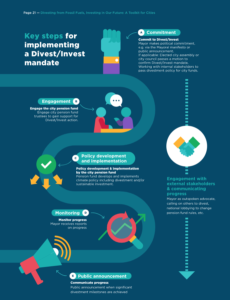Budgeting for Climate Resilience
As the impacts of climate change – and their costs to communities – increase, the urgency to integrate resilience initiatives into our budget processes likewise continues to grow.
Earlier this month, Governor Newsom proposed a $12.5 billion climate budget (as part of the state budget) to be rolled out over five years, including the Greenhouse Gas Reduction Fund ($965 million from cap-and-trade), $1 billion in general fund dollars for a “Climate Catalyst Fund” for low-interest loans for climate-related projects, and a $4.75-billion climate resilience bond that the governor hopes to put in front of voters in November to help reduce risks from water, fire, extreme heat and sea-level rise.

Environmental reporting and budgeting: Climate is money

Paris. An annual ‘Bleu Climat Energie’ report is adopted by the Paris City Council at the same time as the preliminary annual budget, as a way to follow up actions in the Climate and Energy Plan and indicate budgetary, energy and emission savings that have been achieved through these actions. Linking extensive environmental reporting to the budget planning phase is used to align investments with the advancement of climate and energy actions, as well as to account for the additional costs and savings from these actions.
Växjö, Sweden. Växjö appointed an ecoBudget manager, who presents a report to the City Council every six months to take appropriate measures in case that a target might be missed, dealing with events not budgeted for, and keeping politicians informed about budget implementation. The environmental and financial budget reports were integrated into a single document and approved by the City Council at the same time.
Green public procurement: Buying can be climate-smart
Municipal procurement budgets represent a significant opportunity to leverage sustainable and innovative market practices. City staff has to engage with the local economic actors to ensure that their environmental standards are being met, and better understand what is possible in today’s market.
Copenhagen. All of Copenhagen’s agencies are required to integrate environmental and climate requirements in their procurement. A ‘Team Green Public Procurement’ works across all procurement units to provide support for sustainable procurement and market engagement activities involving environmental and climate issues.
Rome. The Metropolitan City of Rome Capital has linked a digital monitoring system for green public procurement (GPP) to its e-procurement platform since 2016. Rome developed its first action plan for green procurement in 2009, which established a manual monitoring system, requiring procurement staff in each department to send a form to the GPP Coordination Office whenever they completed a green purchase. The action plan also set up a Green Purchasing Workgroup to promote sustainable development. GPP reduced CO2 emissions by an estimated 749 tons from 2011 to 2014.
Divesting fossil fuels: Moving our money into clean solutions
Local authorities need to be demanding in the relationships with their banks and fund managers – urging transparency about how these financial-service providers manage the City’s money in terms of environmental-investment criteria and climate risk.
New York City. New York City was the first city in the U.S. to set in motion a comprehensive divestment and investment strategy as part of their Green New Deal to achieve carbon neutrality by 2050. In January 2018, Mayor Bill de Blasio announced that New York City will fully divest from fossil-fuel reserve owners by the end of 2022.
The trustees for three of the five pension funds with assets of around $130 billion agreed to determine a “prudent strategy that responsibly reduces the portfolio’s exposure to carbon risk in general and specifically to fossil fuel owners’ securities.”
The New York City Comptroller is taking the lead in the development of the strategy and is currently commissioning independent advice on the options for implementation. The advisor will further evaluate risks and look at different strategies for divestment.
In September 2018, the Mayor, Comptroller and pension-fund trustees also announced a new goal to double the investments of the City’s pension funds in climate-change solutions to $4 billion, or 2% of its $195-billion pension portfolio over the next three years.

Green municipal bonds: Raising money for climate-smart projects
Earmarking local revenues and other financial instruments

Lausanne. In Switzerland, municipalities are “entitled to levy specific, transparent and clearly defined municipal taxes to support renewable energies, public lighting, energy efficiency and sustainable development.”
The City of Lausanne collects two different taxes per kWh consumed in every household, which are then fed into two funds, one earmarked for energy efficiency and one for sustainable development in general. The amount of the taxes is determined from year to year.
For 2018, both the energy efficiency tax and the sustainable development tax are set at 0.3 ct/kWh each (compared to 0.25 ct/kWh in 2017). The taxes are levied directly by the grid operator and included on the customer’s electricity bill, and then the amounts are transferred to the municipality. In addition to the electricity tax, there are other taxes on gas sales by the Gas and District Heating Service (0.1 ct/kWh) and water sales (3 cts/m3), which feed into the sustainable development fund.
Alameda County. In the East Bay, Alameda County has also implemented a utility bill surcharge for all County departments that funds an energy office to oversee the planning, implementation, financing and tracking of the energy and fiscal impacts of projects.
Go green, save green
Given the increasing awareness of the urgent need to address climate change, cities and counties should be pursuing similar measures to better align their budget, investment and procurement processes to ensure that their local investments are supporting community resilience that will pay off for generations to come.
Resources
- Divesting from Fossil Fuels, Investing in Our Future: A Toolkit for Cities
- Climate-mainstreaming municipal budgets
- Green Purchasing
Local Government Commission Newsletters
Livable Places Update
CURRENTS Newsletter
CivicSpark™ Newsletter
LGC Newsletters
Keep up to date with LGC’s newsletters!
Livable Places Update – April
April’s article: Microtransit: Right-Sizing Transportation to Improve Community Mobility
Currents: Spring 2019
Currents provides readers with current information on energy issues affecting local governments in California.
CivicSpark Newsletter – March
This monthly CivicSpark newsletter features updates on CivicSpark projects and highlights.



